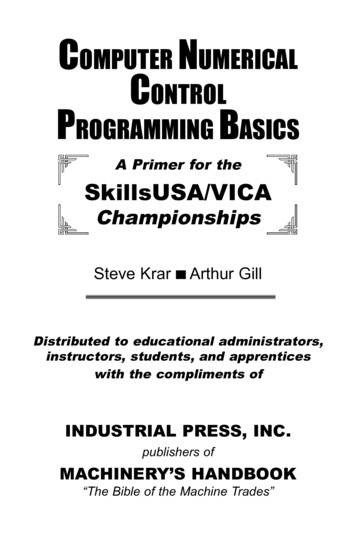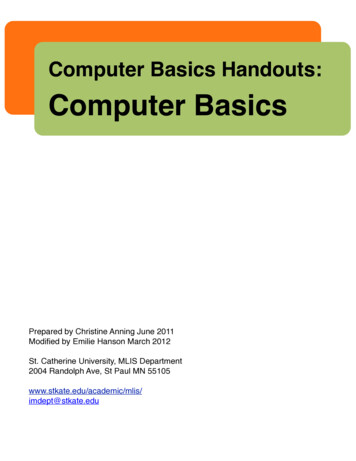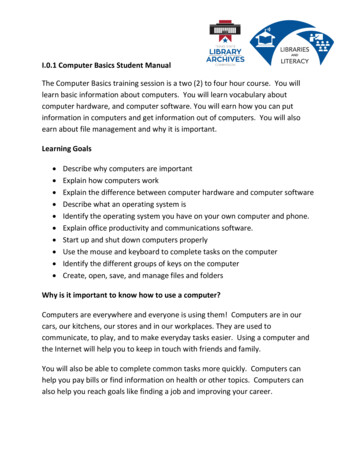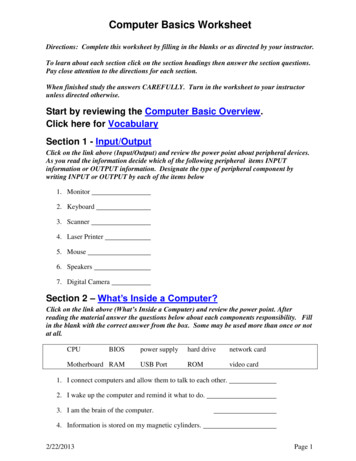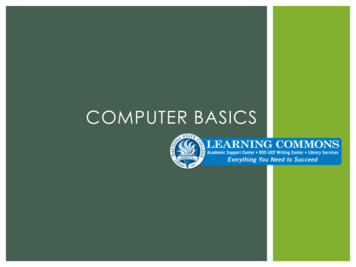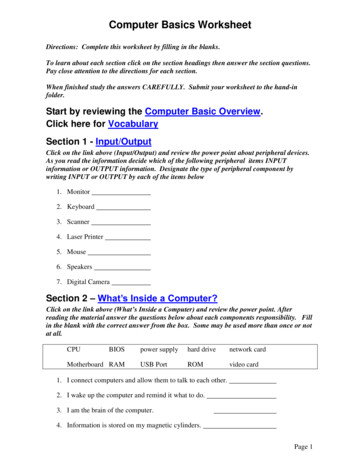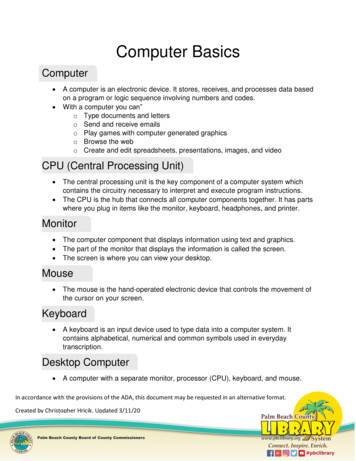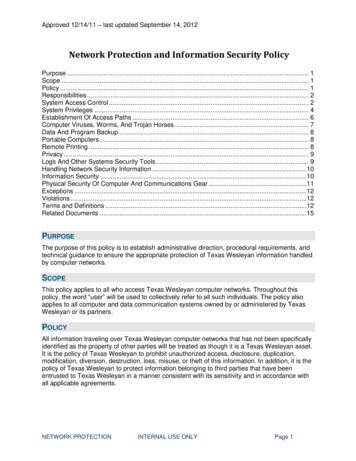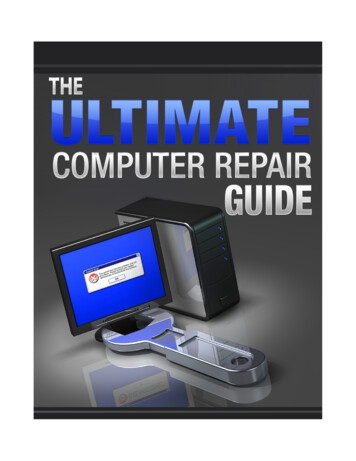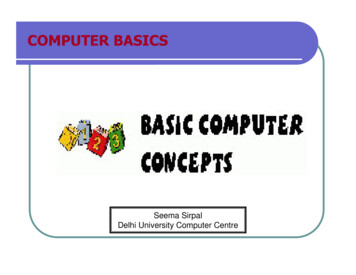
Transcription
COMPUTER BASICSSeema SirpalDelhi University Computer Centre
What is a Computer?An electronic device that stores, retrieves,and processes data, and can beprogrammedwithinstructions.Acomputer is composed of hardware andsoftware, and can exist in a variety ofsizes and configurations.
Hardware & SoftwareThe term hardware refers to the physicalcomponents of your computer such as thesystem unit, mouse, keyboard, monitor etc.The software is the instructions that makesthe computer work. Software is held eitheron your computers hard disk, CD-ROM,DVD or on a diskette (floppy disk) and isloaded (i.e. copied) from the disk into thecomputers RAM (Random Access Memory),as and when required.
Types of ComputersMini and Mainframe ComputersVerypowerful,usedbylargeorganisations such an banks to controlthe entire business operation. Veryexpensive!Personal ComputersCheap and easy to use. Often used asstand-alone computers or in a network.May be connected to large mainframecomputers within big companies.
Hardware ComponentsInput Devices -- "How to tell it what to do“- A keyboard and mouse are the standard way tointeract with the computer. Other devices includejoysticks and game pads used primarily for games.Output Devices -- "How it shows you what it is doing"- The monitor (the screen) is how the computersends information back to you. A printer is also anoutput device.
Hardware ComponentsINPUT DEVICES The Mouse Used to ‘drive’ Microsoft WindowsThe Keyboard The keyboard is still the commonestway of entering information into acomputerTracker Balls an alternative to the traditional mouseand often used by graphic designers
Hardware ComponentsINPUT DEVICES Scanners A scanner allows you to scan printed materialand convert it into a file format that may beused within the PC Touch Pads A device that lays on the desktop and respondsto pressure Light Pens Used to allow users to point to areas on ascreen Joysticks Many games require a joystick for the properplaying of the game
Hardware ComponentsOUTPUT DEVICES VDU The computer screen is used for outputtinginformation in an understandable format Printers There are many different types of printers. In large organizations laser printers aremost commonly used due to the fact thatthey can print very fast and give a veryhigh quality output.
Hardware ComponentsOUTPUT DEVICES Plotters A plotter is an output device similar to aprinter, but normally allows you to printlarger images. Speakers Enhances the value of educational andpresentation products. Speech synthesisers Gives you the ability to not only to displaytext on a monitor but also to read the textto you
Hardware ComponentsStorage Devices -- "How it saves data andprograms“- Hard disk drives are an internal,higher capacity drive which also stores theoperating system which runs when you poweron the computer.- "Floppy" disk drives allow you to savework on small disks and take the data withyou.
Hardware ComponentsHard Disks Speed: Very fast! The speed of a hard disk is often quoted as "averageaccess time" speed, measured in milliseconds. Thesmaller this number the faster the disk.Capacity: Enormous! Often 40/80 Gigabytes. A Gigabyte isequivalent to 1024 Megabytes.Cost: Hard disks costs are falling rapidly and normallyrepresent the cheapest way of storing data.
Hardware ComponentsDiskettes (Floppy Disks) Speed: Very slow!Capacity: Normally 1.44 Mbytes.Cost: Very cheap.
Hardware ComponentsCD-ROM Disks Speed: Much slower than hard disks. The originalCD-ROM speciation is given a value of 1xspeed, and later, faster CD-ROMs arequoted as a multiple of this value.Capacity: Around 650 Mbytes and more
Hardware ComponentsDVD Drives Speed: Much faster than CD-ROM drives butnot as fast as hard disks.Capacity: Up to 17 Gbytes.Cost: Slightly higher than CD-ROM drives.
Main Parts of ComputerMemory -- "How the processor stores and usesimmediate data“ RAM - Random Access Memory The main 'working' memory used by the computer. When the operating system loads from disk when youfirst switch on the computer, it is copied into RAM. As a rough rule, a Microsoft Windows based computer willoperate faster if you install more RAM. Data andprograms stored in RAM are volatile (i.e. the informationis lost when you switch off the computer).
Hardware ComponentsMemory ROM – Read Only Memory Read Only Memory (ROM) as the name suggests is a specialtype of memory chip that holds software that can be readbut not written to. A good example is the ROM-BIOS chip, which contains readonly software. Often network cards and video cards also contain ROMchips.
Hardware ComponentsHow Computer Memory Is Measured BitAll computers work on a binary numbering system, i.e. theyprocess data in one's or zero's. This 1 or 0 level of storage iscalled a bit.Byte A byte consists of eight bits.Kilobyte A kilobyte (KB) consists of 1024 bytes.Megabyte A megabyte (MB) consists of 1024 kilobytes.Gigabyte A gigabyte (GB) consists of 1024 megabytes.
Hardware ComponentsMicroprocessors -- "The brain of the computer“- PCs primarily use microprocessors (sometimes called the chip).The older Intel versions include the 386, 486 and now the Pentiumline.The CPU (Central Processing Unit) is normally an IntelPentium (or equivalent) and it is one of the most importantcomponents within your computer. It determines how fast your computer will run and ismeasured by its MHz speed. Thus a 600 MHz Pentium is much faster than say a 400MHz Pentium CPU. It is the CPU that performs all the calculations within thecomputer.
Hardware ComponentsSome of the FactorsThat Impact on a Computer's Performance CPU speedRAM sizeHard disk speed and capacity
Software ComponentOperating systems softwareThe operating system is a special type of program that loadsautomatically when you start your computer.The operating system allows you to use the advanced features ofa modern computer without having to learn all the details of howthe hardware worksThe link between the hardware and you, the userMakes the computer easy to use without having to understand bitsand bytes!
Software ComponentApplications softwareAn application program is the type of program thatyou use once the operating system has been loaded.Examples include word-processingspreadsheets and databasesprograms,
Software ComponentApplication Software Word processing applications Microsoft Word Lotus Word Pro WordPerfect Spreadsheets Microsoft Excel Lotus 123 Database Microsoft Access Lotus Approach
Software ComponentApplication Software Payroll Sage software Presentation tools Microsoft PowerPoint Lotus Freelance Desktop publishing Abode Photoshop Multimedia applications Microsoft's Encarta CD-ROM basedencyclopaedias
Information Network LAN A LAN (Local Area Network) is a system wherebyindividual PCs are connected together within acompany or organization WAN A WAN (Wide Area Network) as the name impliesallows you to connect to other computers over awider area (i.e. the whole world).
Information NetworkUses of NetworkIf ten people are working together within an office itmakes sense for them all to be connected. In this way the office can have a single printerand all ten people can print to it. In a similar way other devices such as modems orscanners can be shared. Even more useful is the ability to shareinformation when connected to a network.
Computer Accessories Modem Short for “MODulate/DEModulate”.The modemsends information from your computer across thetelephone system. The modem at the other end of the phone line,converts the signal back into a format that can beused by the receiving computer.
Uses of ComputerPC at HomeCommon uses for the computer within the home Computer gamesWorking from HomeBanking from HomeConnecting to the Web
Uses of ComputerComputers in Education CBT (Computer Based Training) Computer Based Training (CBT) offers a low costsolution to training needs where you need to traina large amount of people on a single subject. These programs are normally supplied on CD-ROMand combine text, graphics and sound. Packages range from general encyclopaedias rightthrough to learning a foreign language.
Uses of ComputerOffice Applications Automated Production Systems Many car factories are almost completely automated and thecars are assembled by computer-controlled robots. Thisautomation is becoming increasingly commonthroughout industry. Design Systems Many products are designed using CAD (Computer AidedDesign) programs to produce exact specifications anddetailed drawings on the computer before producing modelsof new products.
Uses of ComputerOffice Applications Stock Control Stock control is ideal for automation and in many companiesit is now completely computerized. The stock control system keeps track of the number of itemsin stock and can automatically order replacement itemswhen required.Accounts / Payroll In most large organizations the accounts are maintained bya computerized system. Due to the repetitive nature of accounts a computer systemis ideally suited to this task and accuracy is guaranteed.
Uses of ComputerComputers in Daily Life AccountsGamesEducationalOn-line bankingSmart ID cardsSupermarketsWorking from home (Tele-working)Internet
Create a Good Working Environment Frequent breaks away from the computer Appropriate positioning of screens, chairs andkeyboards Provision of adequate lighting and ventilation.
Health & Safety Precautions Make sure that cables are safely secured Make sure that power points are not overloaded Also be aware of: Repetitive Strain Injury (RSI) Glare from screens Bad posture
Value of Backup The most important thing that you storeon your computer is information. Often the contents of a hard disk canrepresent years of work. If the hard disk stops working one day youcould lose all those years of work. For this reason it is VITAL that you takeregular backups of the information that isstored on the computer.
Value of Backup Organize your computer for more efficientbackups Complete vs. incremental backups Use 'off-site' storage
Value of Backup Use passwords Understand the Importance of shuttingdown your computer properly Use a UPS (Un-interruptible Power Supply)
Likes & Dislikes of Computer Things computer like: Good ventilation Clean environment Stable, vibration free surfaceThings computer don’t like: Dust Drinking and eating over the keyboard Heat, Cold or Moisture Don’t place objects on top of monitors. Don’t place floppy disks near monitors.
Computer Virus What are computer viruses? Viruses are small programsthat hide themselves on yourdisks (both diskettes andyour hard disk).Unlessyouusevirusdetection software the firsttime that you know that youhave a virus is when itactivates.Differentvirusesareactivated in different ways.
Computer Virus How do viruses infect PCs? Viruses hide on a disk and when youaccess the disk (either a diskette oranother hard disk over a network) thevirus program will start and infectyour computer. The worst thing about a computervirus is that they can spread from onecomputer to another, either via use ofinfected floppy disk, or over acomputer network, including theInternet.
Computer Virus How to prevent virus damage There are a number of third party antivirus products available.Most of these are better than the ratherrudimentary products available withinDOS and Windows, but of course you dohave to pay for them!The main thing about your virus checkeris that it should be kept up to date.Many companies supply updated disks ona regular basis or allow you to receiveupdates through an electronic, on-linebulletin board.
Software Copyright Be aware on software copyright issuesFreewareSharewareWhat about software that you find onthe Internet?Software site licenses
Software Copyright If your computer system holdsinformation about individuals then youhave a moral and legal duty to treatthat information with respect.In a free society you have a right toensure that information held aboutyou is not abused.In many countries this right isenshrined under data protection laws
Now Let us start our Computersand get going
COMPUTER BASICS Seema Sirpal Delhi University Computer Centre. What is a Computer? An electronic device that stores, retrieves, and processes data, and can be programmed with instructions. A computer is composed of hardware and software, and can exist in a variety of sizes and configurations. Hardware & Software The term hardware refers to the physical components of your computer such


